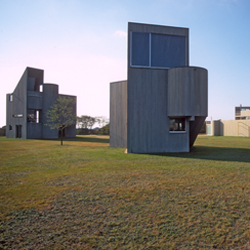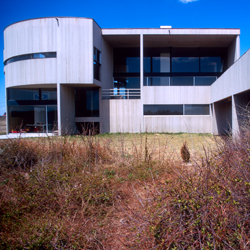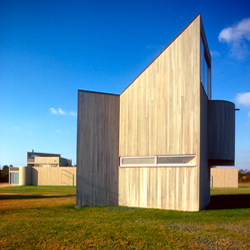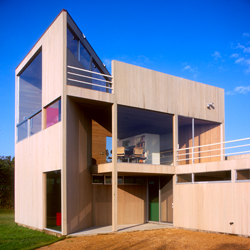Hamptons Houses
Architecture as Idea: Charles Gwathmey
In 1965, a young Charles Gwathmey began designing a house and studio for his parents in Amagansett, Long Island. With their earthy and simple geometric shapes (cylinders, rectangles, and squares), Gwathmey’s structures, the first of their kind, revolutionized the landscape. Gwathmey was an innovator, purist, and one of the New York Five—a group of architects also known as the “whites” for their adherence to the tenets of High Modernism. He would later come to be known as THE Hamptons architect: the one that other architects imitated. In 1971, Bill Maris captured the formal, sculptural quality of Gwathmey's small-scale structures in the lone image that survives in this collection.
The Tolan House, photographed by Maris that year, was an aesthetic extension of these first structures. Maris emphasizes the house’s strong lines and angular, complex geometry. Standing outside, he abstracts the structure by capturing the building’s jutting triangular exterior from the side so that it appears to be pure form: an almost two-dimensional construction. Gwathmey’s Arthur Steele, Jr. house, in Bridgehampton, which Maris photographed for House and Garden in 1971, echoes these pure, strict geometric shapes but on a much larger scale. Maris positions his camera almost under the walkway to the dunes, emphasizing the solidity of the shape and the way that inside and outside flow together. “The best homes,” according to Gwathmey, “have a spirituality which is unforgettable. In other words, if you went to any of those buildings, you’d remember them for your life.”
The Tolan House, photographed by Maris that year, was an aesthetic extension of these first structures. Maris emphasizes the house’s strong lines and angular, complex geometry. Standing outside, he abstracts the structure by capturing the building’s jutting triangular exterior from the side so that it appears to be pure form: an almost two-dimensional construction. Gwathmey’s Arthur Steele, Jr. house, in Bridgehampton, which Maris photographed for House and Garden in 1971, echoes these pure, strict geometric shapes but on a much larger scale. Maris positions his camera almost under the walkway to the dunes, emphasizing the solidity of the shape and the way that inside and outside flow together. “The best homes,” according to Gwathmey, “have a spirituality which is unforgettable. In other words, if you went to any of those buildings, you’d remember them for your life.”




